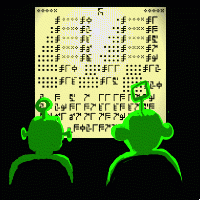Oops!

Dr Yvan Dutil has been losing sleep lately. Why? Because he and his colleague Dr. Stéphane Dumas have proved to be only human.
Dutil and Dumas, astronomers at the Defence Research Establishment Valcartier in Canada, have written a 23-page message that has recently been beamed as a radio signal towards four Sun-like stars between 51 and 71 light years away from Earth. It was sent out three times during the course of three hours on May 24, from a Ukranian observatory. The message used a code designed to make it readable even if the signal should become degraded during its long journey across interstellar space.
The recent message isn't the first to be sent into space: in 1974 the US radio astronomer Frank Drake beamed one towards stars that we now know are unlikely to have planets. His message consisted of a series of 1,679 pulses which, when arranged into a matrix, became an image showing atoms, molecules, our Solar System and a representation of a human.
Dutil and Dumas' message contains information about the Earth, plus descriptions of mathematics and physics, coded in symbols that an intelligent alien species should be able to puzzle out. It consists of a series of pages, starting with basic symbols and going on to describe numbers and geometry using logic, and finally introducing such concepts as atoms, planets and even DNA. The total length of the 23 encrypted pages is around 400,000 bits.
It was a Dutch computer programmer, Paul Houx, who noticed that the astrophysicists had twice used the wrong symbol for an equals sign in a geometry page. "I'm afraid we might be judged as a sloppy species by the League of Galactic Civilisations," joked Houx.
Unfortunately for Dutil and Dumas, although the error was noticed by Houx prior to transmission it was impossible to update the message before sending it. The Evpatoriya observatory in the Ukraine, from where it was sent, has no Internet connection and therefore there was no way to change the message in time. Fortunately, any extraterrestrial species advanced enough to have built a radio telescope able to pick up the signal should be able to figure out the message anyway.
The final page of the message invites recipients to reply. Sadly for Dutil and Dumas, they probably won't be around to find out whether or not the call is answered: given that the target stars are at least 50 light years away, it would be at least 100 years before any return message got back to us, even if the aliens were to reply straight away.
- Finding the error
- How Paul Houx noticed the problem.
- SETI
- The Search for Extra-Terrestrial Intelligence project.